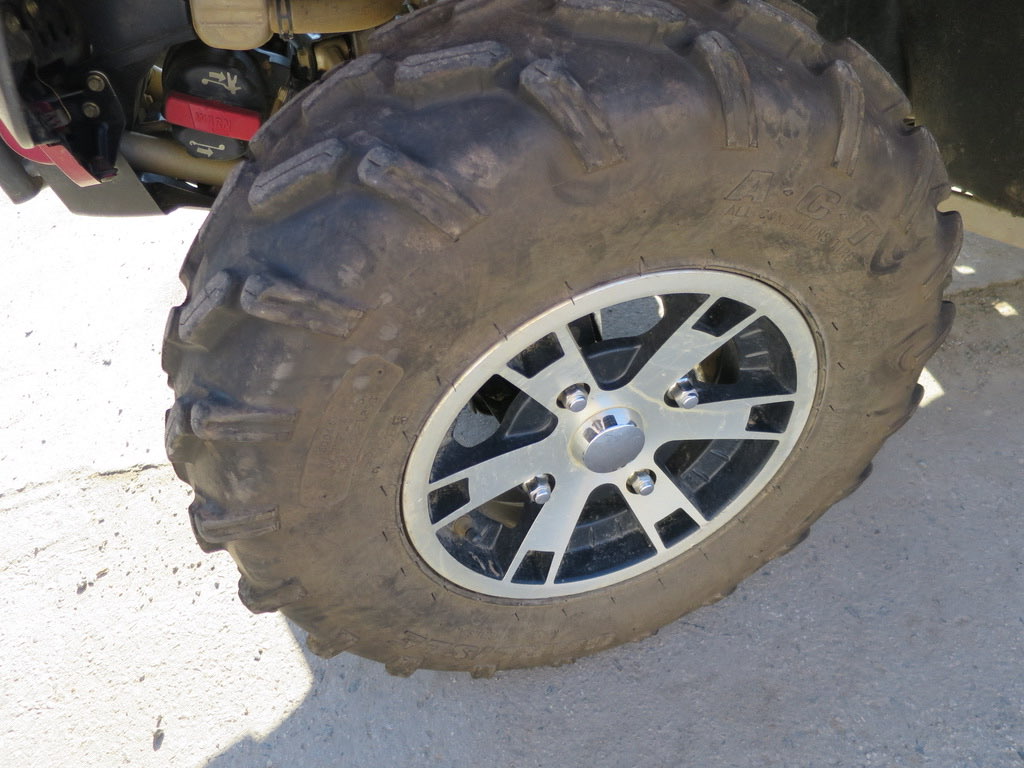If you have an ATV, and it has a flat tire, you may be wondering if the tire can be plugged?
- Can tires be patched or plugged?
- Can you plug tire sidewall?
- Is it better to plug or patch a tire?
In this article, we will answer all of these questions and more.
We will also discuss when it is better to replace an ATV tire instead of fixing it. So, whether you are looking for information on how to fix a small hole in your tire or how to find a leak in your tire, we have you covered!
The short answer is yes, ATV tires can be plugged. However, it is important to note that not all holes in tires can be safely plugged.
For example, if the hole in your tire is too large, or if the tire has been punctured in multiple places, it is likely that the tire will need to be replaced.
In addition, it’s often recommended against plugging an ATV tire sidewall or even close to the sidewall.
How to Find the Leak in Your ATV Tire
To find the hole in your tire is very simple, all you need is a spray bottle with soapy water.
This soapy water can be regular water from the sink and the soap can be hand soap or dish soap, whichever you have handy. No need to overthink it, put mostly water in the spray bottle and then add some soap, and that is it.
With the ATV secured and not moving, lift the ATV tire up that is leaking air. Make sure the tire has air in it or this will not work.
Take the spray bottle with soapy water and spray the ATV tire until you start to see bubbles coming out. When you see bubbles, you found the leak and can work to patch the tire. If you see no bubbles, then add more soap to the water or the hole is not leaking, or the tire is out of air.
How to Plug ATV Tire With Tire Plug Kits
One of the most common ways to plug an ATV tire is with a tire plug kit (ad). These kits typically come with everything you need to plug a hole in your ATV tire, including a plugging tool and several plugs.
To use a tire plug kit, you must remove whatever is causing the hole if it’s still in the tire, this could be a nail, staple, torn, or whatever.
Once you remove the item from the tire, you need to clean the hole with the included tool, this will make entering the patch easier.
Then insert the plug into the puller, coat the plug with the supplied glue, insert into the hole, and quickly pull out the handle and this will leave the plug behind. Cut off any excess plug that protrudes too much out.
Here are video instructions:
Avoid Slime Tire Repair
Slime is a product that can be used to fix flat tires. It is a thick, gooey substance that is inserted into the tire through the valve stem.
Once in the tire, it quickly expands and seals any holes or leaks.
While slime can be an effective way to fix a flat tire, it is not recommended for use on ATV tires.
This is because ATV tires typically have larger holes and punctures than car tires, and as such, they require a more substantial repair. Slime also creates a mess and will only piss off the tire guy and can make your tire unbalanced.
Generally, I like to avoid Slime, but that is me.
ATV Tire Keeps Going Flat
If your ATV tire keeps going flat after siting, then we have a post that can help you here.
Patching vs Plugging ATV Tires
Now that we’ve answered the question “Can ATV tires be plugged?” let’s discuss the pros and cons of patching vs plugging ATV tires.
Patching an tire is typically considered to be a more permanent repair than plugging.
This is because a patch covers the entire hole and little around the hole, while a plug only covers the hole.
Patches are also better for bigger holes and odd shaped holes, especially ones that are not straight or perfectly round. A patch should not be used to repair sidewalls, generally, a new tire is needed when you puncture the sidewalls.
Plugging a tire is considered to be a temporary repair, but can last if done right.
However, plugs are typically much easier to install than patches, and they can often be done without having to take the wheel off the ATV.
So, Which Is Better? Patching or Plugging?
The answer depends on the situation. If you have a small hole in your tire that is not leaking too much air, then a plug is all you need.
However, if you have a large hole in your tire that is leaking a lot of air, then a patch may be necessary.
But to be honest, if the tire is leaking a lot, and you’re considering a patch, you should also consider replacing the tire too. A hole in a tire too large can’t be fixed easily and often means you need a new one. It’s best to not patch or plug a hole that is larger than 1/4 inch diameter, you need a new tire at that point.
One final note on ATV tires: If you have a flat tire, it is important to get it fixed as soon as possible.
Riding an ATV on a flat tire can damage the rim and tire and make it more difficult to fix.
In addition, riding on a flat tire can also damage your ATV’s suspension and other components. Bending your ATV rim because you drove on a flat tire is much worse than having to fix a flat tire, so fix the tire right away.
